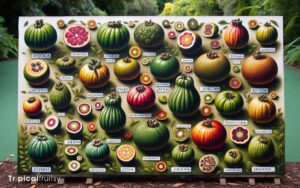What to Do with Feijoa Skins? Creative Twist!
Feijoa skins, often discarded as waste, can be repurposed in a variety of innovative ways, adding flavor, aroma, and utility to everyday items.
These skins can be used to brew a unique tea, create a natural sugar scrub for skincare, enhance the taste of infused waters, provide natural food coloring, repel garden pests, and even be turned into aromatic potpourri or flavorful extracts.
Embracing the versatility of feijoa skins not only reduces waste but also unlocks new culinary and household applications.
The feijoa skin is an underutilized resource with multiple uses:
Unlock the hidden potential of feijoa skins and turn your kitchen discards into delightful, eco-friendly treasures.
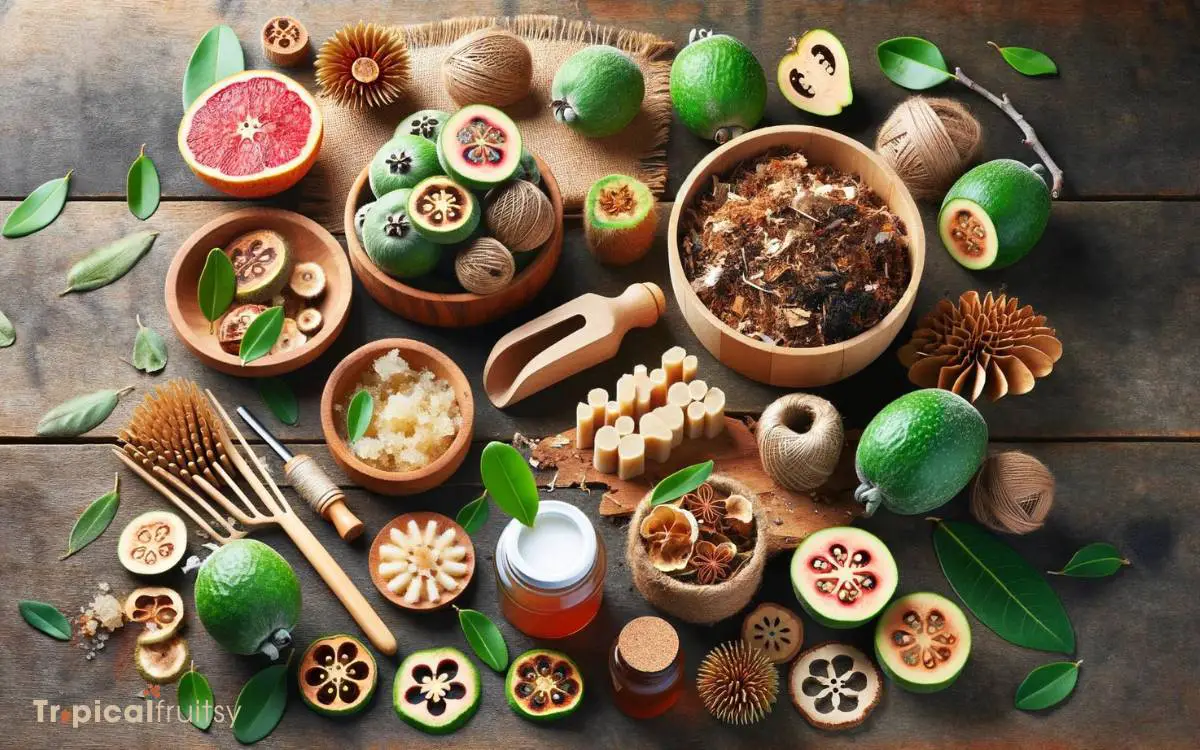
Key Takeaway
Creative Uses for Feijoa Skins: From Tea to Potpourri
| Use for Feijoa Skins | Description | Application |
|---|---|---|
| Homemade Tea | Brewing the skins for a unique flavored tea. | Beverage |
| Sugar Scrub | Mixing the skins with sugar for a skin exfoliant. | Skincare |
| Infused Water | Flavoring water by infusing skins. | Beverage |
| Natural Food Coloring | Using the skins to naturally color food. | Cooking |
| Pest Deterrent | Utilizing the scent to deter garden pests. | Gardening |
| Potpourri | Drying the skins for use in aromatic potpourri. | Home Fragrance |
| Flavor Extract | Creating extracts by simmering skins in alcohol. | Cooking |
Composting Feijoa Skins
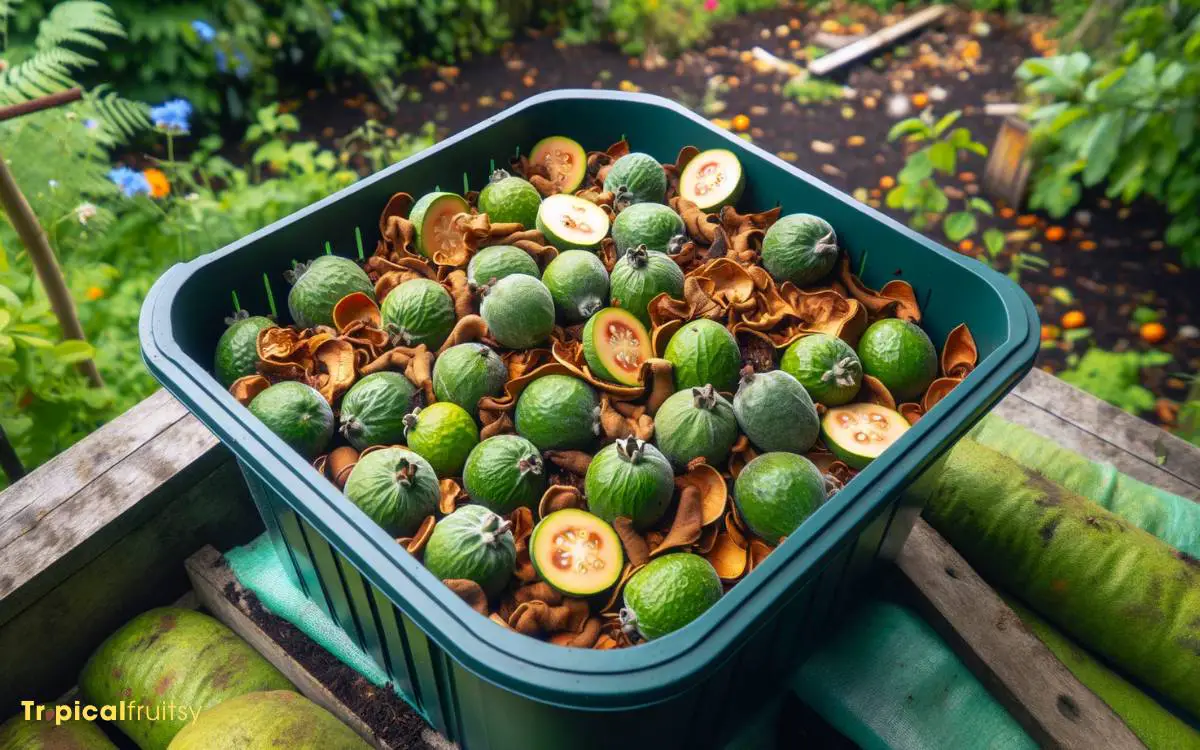
Composting feijoa skins turns this often-discarded fruit waste into valuable garden nutrients. It’s a straightforward, eco-friendly process that significantly enriches soil quality.
When feijoa skins are added to a compost pile, they break down over time, thanks to the work of microorganisms. The resulting compost is packed with essential minerals that plants crave.
It’s important to chop the skins into smaller pieces to speed up decomposition. They should then be mixed with a balance of green and brown compost materials to ensure proper aeration and moisture levels.
This not only recycles the feijoa skins but also reduces landfill waste, making it a practical solution for gardeners who are environmentally conscious and seeking sustainable practices.
Homemade Feijoa Tea
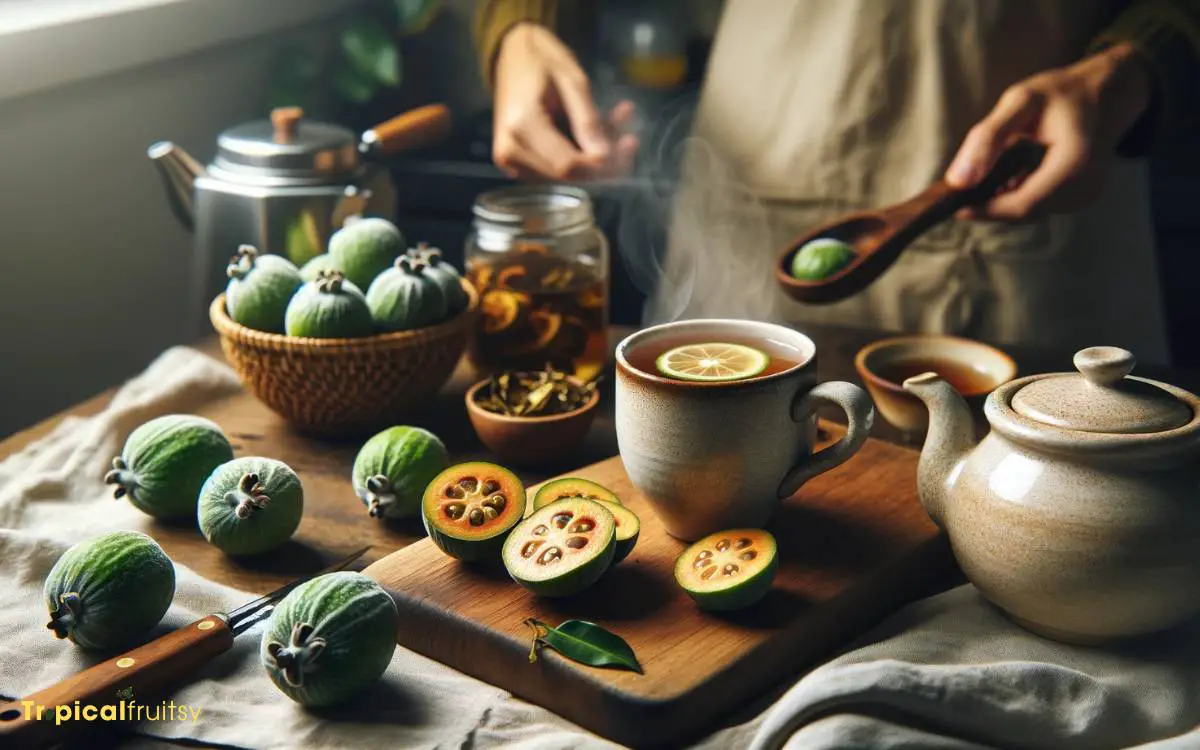
Turning the gardener’s feijoa skins into a fragrant homemade tea offers a delightful way to enjoy their unique flavor while reducing waste. This eco-friendly process transforms what would be trash into a soothing beverage.
Here’s how one can make their own feijoa skin tea:
- Wash the Skins: Ensure they’re free from any dirt or residues.
- Dry the Skins: Either air-dry them or use a dehydrator until they’re completely moisture-free.
- Steep in Hot Water: Place the dried skins in a teapot, pour boiling water over them, and let them steep for several minutes.
- Strain and Serve: Remove the skins and enjoy the tea hot, or chill for a refreshing cold drink.
It’s a simple, yet thoughtful way to savor feijoas to the fullest.
Feijoa Skin Sugar Scrub
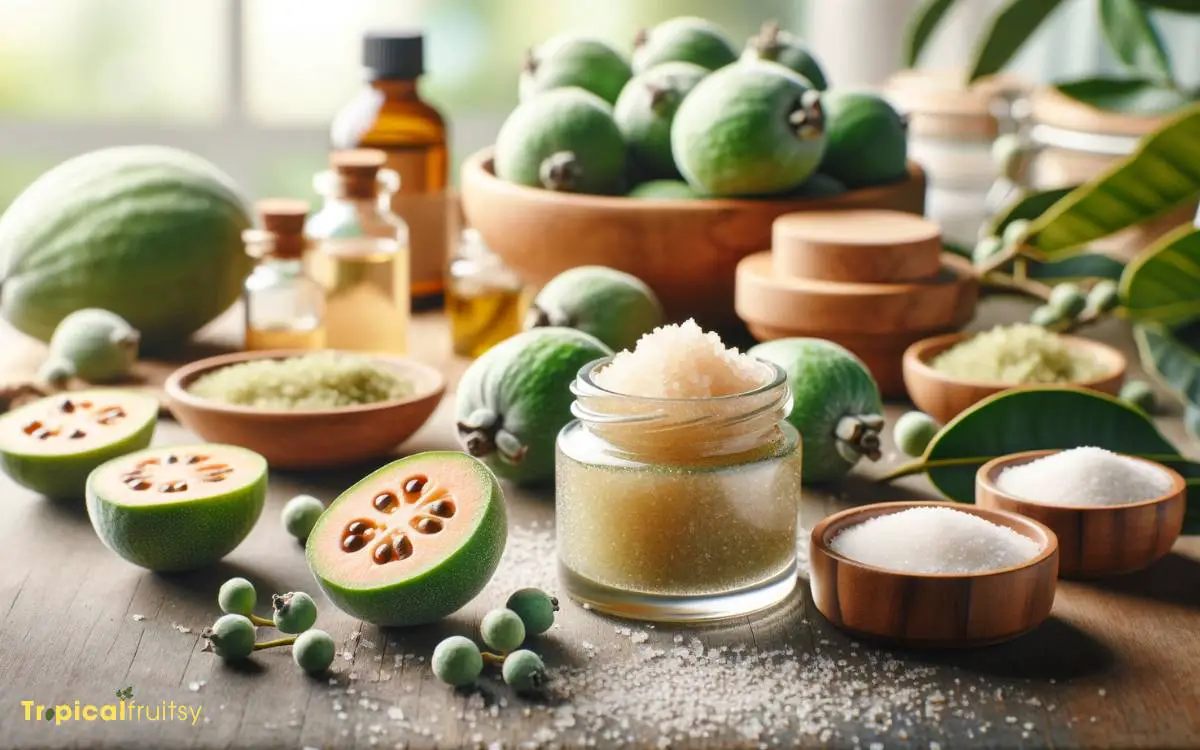
Feijoa skin sugar scrub offers a natural and fragrant exfoliating option for skincare enthusiasts looking to repurpose their fruit waste.
The rough texture of the sugar paired with the beneficial properties of feijoa skins creates a scrub that not only smooths the skin but also imbues it with a subtle, fresh scent.
To make it, one simply needs to dry the skins, grind them finely, and mix them with a sugar base. This mixture can then be combined with a touch of oil, such as coconut or olive, to bind and moisturize.
It’s a simple, effective way to reduce waste and treat the skin gently. Plus, it aligns with an eco-conscious lifestyle, turning leftovers into luxury.
Infused Water Enhancements
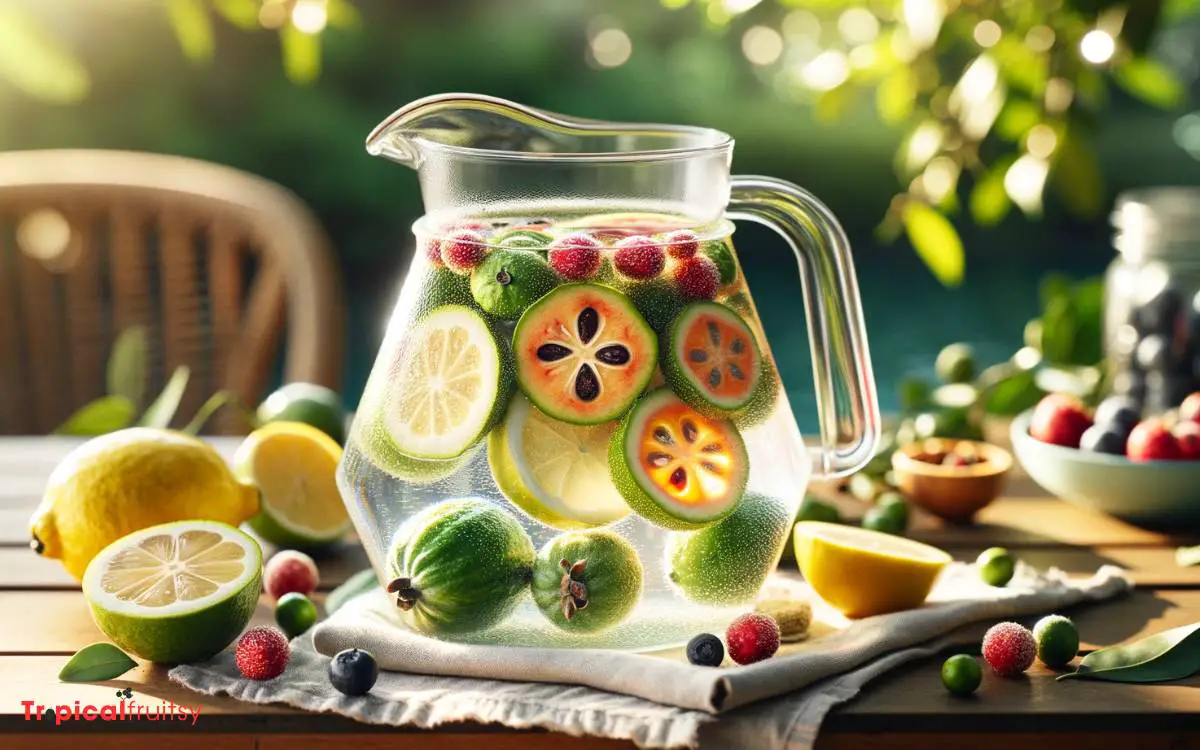
Turning to infused water enhancements, one can repurpose feijoa skins to add a unique twist to their hydration routine.
They’ll explore various methods to infuse the aromatic zest of feijoa skins into water, discussing the potential health benefits and suggesting delectable pairing combinations.
This practice not only elevates the taste of plain water but also aligns with a sustainable lifestyle by reducing food waste.
Flavor Infusion Methods
While you might typically discard them, feijoa skins can add a unique twist to your water by infusing it with their fragrant flavor.
Transforming your plain water into a refreshing beverage doesn’t just elevate the taste; it’s also a sustainable practice that reduces food waste.
Here’s how you can do it:
- Wash the Skins: Thoroughly clean the feijoa skins to remove any dirt or residues.
- Cold Infuse: Place the skins in a pitcher of water and refrigerate for several hours, allowing the essence to seep in gently.
- Warm Infusion: For a quicker method, steep the skins in hot water for a few minutes, then cool the infusion.
- Pair with Herbs: Enhance the flavor by adding complementary herbs like mint or lemon balm.
This simple process not only maximizes the use of feijoas but also provides an eco-friendly solution to enjoy their exotic taste.
Health Benefits

Infusing water with feijoa skins not only improves the flavor but also introduces several health benefits, including a boost in vitamin C and dietary fiber. When consumed regularly, these enhancements can contribute to overall well-being.
By repurposing the skins, individuals not only gain nutritional benefits but also contribute to waste reduction, aligning with an eco-conscious lifestyle.
Here’s a quick glance at the perks of feijoa skin-infused water:
| Benefit | Description |
|---|---|
| Vitamin C | Enhances immune function and skin health. |
| Fiber | Supports digestion and may aid in weight management. |
| Antioxidants | Protects cells from oxidative stress. |
| Hydration | Improves water’s appeal, potentially increasing intake. |
| Zero Waste | Utilizes the whole fruit, reducing food waste. |
Embracing the infusion of feijoa skins into water is a practical, health-conscious choice that benefits both the individual and the environment.
Pairing Combinations
How can you elevate the taste and health benefits of your feijoa skin-infused water? By pairing it with complementary flavors, not only do you enhance its taste, but you can also boost its nutritive value.
Here are four delightful pairings to try:
- Mint & Lemon: Adds a refreshing zing that’s perfect for hydration on a hot day.
- Ginger & Honey: Offers a warming and soothing combination that can aid digestion.
- Cucumber & Lime: Provides a crisp, clean taste that complements the subtlety of feijoa.
- Strawberry & Basil: Creates a sweet and herbaceous profile, making your water a delightful treat.
These pairings aren’t just flavorful; they’re also practical and eco-conscious ways to use all parts of the fruit, aligning with a sustainable lifestyle.
Natural Food Coloring
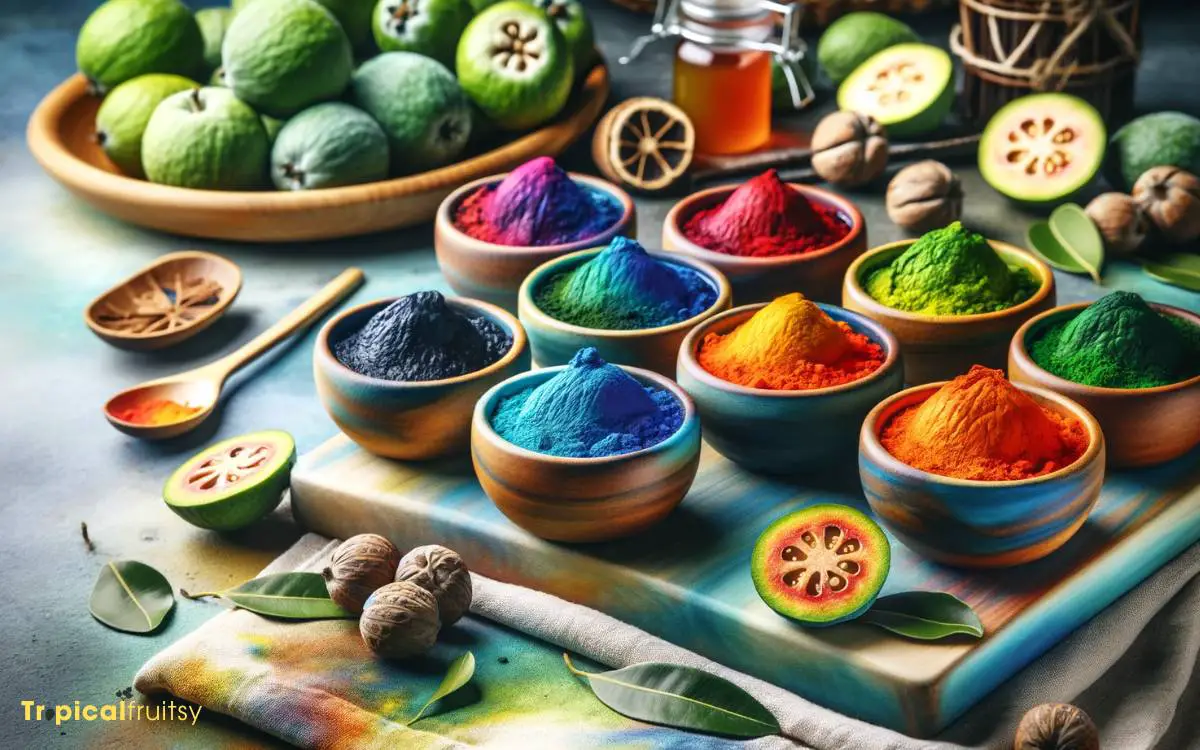
Feijoa skins offer a sustainable way to create natural food coloring, turning kitchen waste into a useful ingredient. One can easily make DIY feijoa dye by simmering the skins in water, extracting their vibrant hues.
To ensure the colors remain stable in various dishes, it’s important to follow some practical tips on color preservation.
DIY Feijoa Dye
Turning feijoa skins into a natural food dye offers an eco-friendly way to add vibrant hues to your culinary creations.
Here’s how to make your own DIY feijoa dye:
- Collect and rinse the skins from ripe feijoas to remove any dirt or debris.
- Chop the skins into small pieces to maximize the surface area that’ll be exposed during the dyeing process.
- Place the chopped skins in a pot, cover with water, and bring to a gentle simmer. Allow the mixture to cook until the water takes on a rich color, usually after about 30 minutes.
- Strain the liquid, discarding the solids, and let the dye cool before using it to color foods or beverages.
Color Stability Tips
To ensure the longevity of your homemade feijoa dye, it’s essential to understand how natural colors behave and how they can be stabilized in various culinary applications.
Natural dyes, like the one derived from feijoa skins, are prone to fading and can change when exposed to different pH levels or temperatures.
To combat this, add a splash of vinegar to acidify the dye, which often helps in preserving the brightness of the color.
When using the dye in baking, be mindful that heat can alter the color, so experimenting with lower temperatures might be beneficial.
For cold dishes, incorporate the dye at the last stage to avoid prolonged exposure to light and air, which can degrade the color.
Choosing eco-friendly, natural food coloring is a sustainable choice that adds a unique twist to your culinary creations.
Feijoa Skin Potpourri
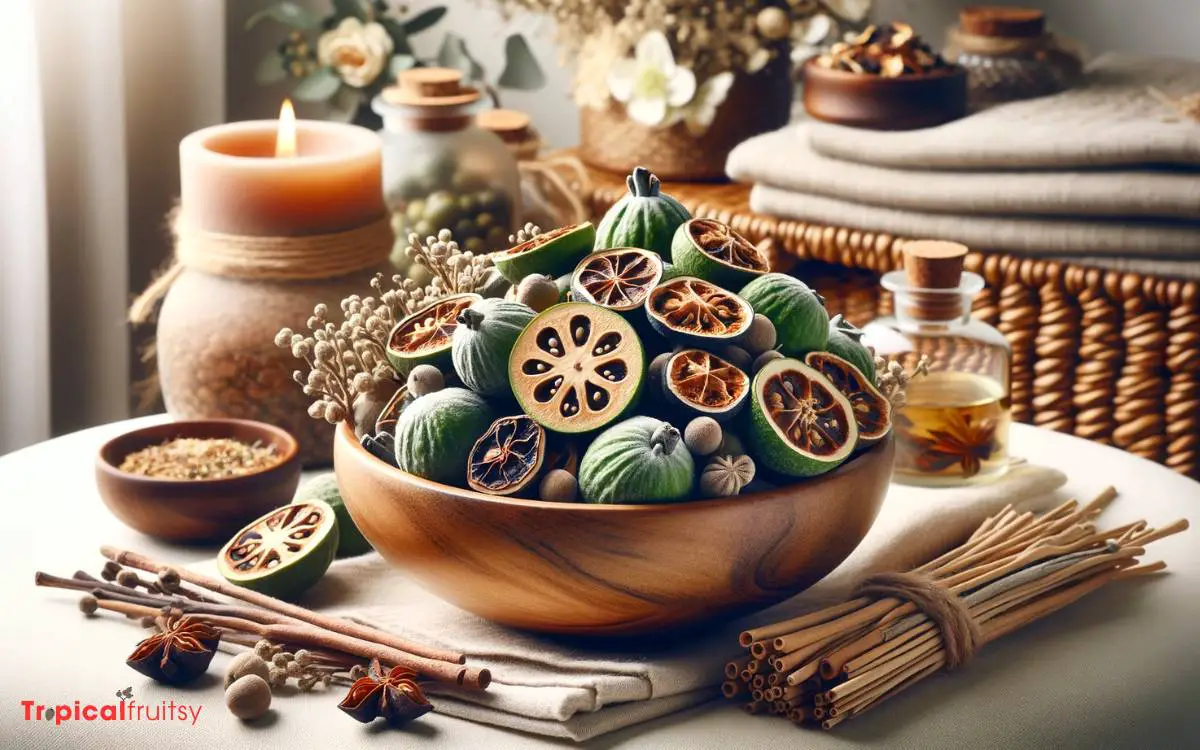
Repurposing feijoa skins into aromatic potpourri offers an eco-friendly way to freshen up your home. It’s a creative and sustainable solution that transforms waste into a delightful, natural air freshener.
Here’s how to make your own feijoa skin potpourri:
- Dry the Skins: Carefully dry feijoa skins by laying them out in a sunny spot until they’re brittle to the touch.
- Add Complementary Scents: Mix the skins with other dried flowers, spices, or citrus peels to enhance the fragrance.
- Essential Oils Boost: Sprinkle a few drops of essential oil for a stronger scent.
- Display and Refresh: Place the mixture in an open container and refresh with additional oils as needed.
This method not only recycles but also infuses your space with a unique, natural aroma.
Drying and Powdering Skins
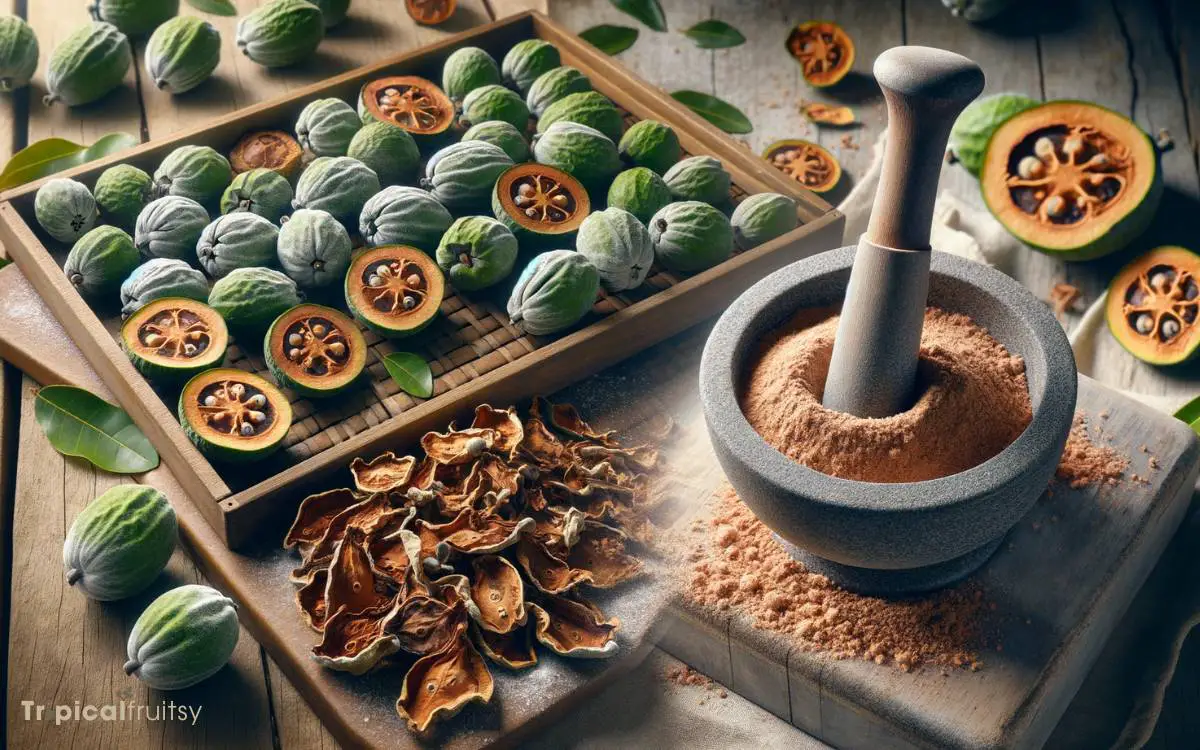
Beyond simply tossing out feijoa skins, you can dry and powder them for use as a natural flavor enhancer in cooking and baking. This process maximizes the use of the fruit and aligns with eco-conscious practices.
To start, clean the skins thoroughly and arrange them in a single layer on a dehydrator tray or a baking sheet. If using an oven, set it to the lowest temperature and leave the door slightly ajar to allow moisture to escape.
Once the skins are completely dry and brittle, grind them into a fine powder using a spice grinder or food processor. This homemade feijoa powder adds a unique twist to smoothies, yogurts, and baked goods.
Feijoa Flavor Extract
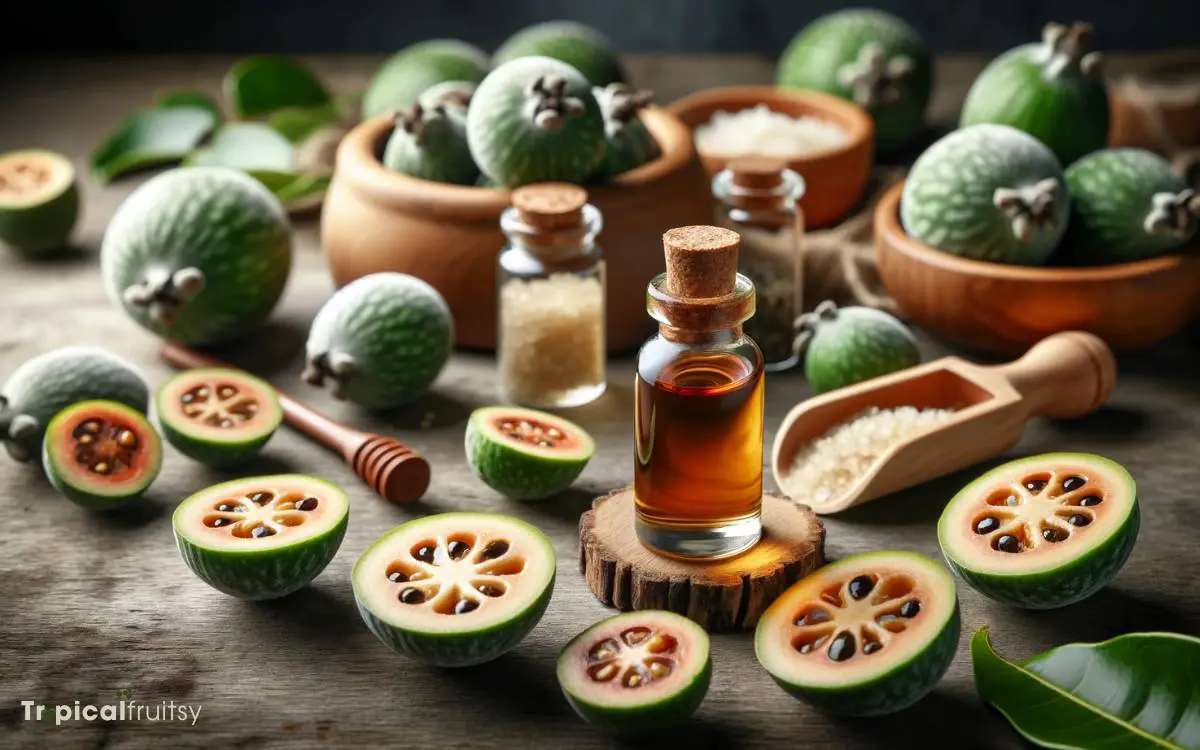
Creating a feijoa flavor extract is another innovative way to utilize the aromatic skins of the fruit, offering a concentrated essence for various culinary applications.
Here’s how to make an eco-friendly, homemade feijoa extract:
- Collect and Clean: Gather feijoa skins and rinse them thoroughly to remove any debris.
- Infuse in Alcohol: Submerge the skins in a neutral spirit, like vodka, ensuring they’re fully covered, and seal the container.
- Patiently Wait: Let the mixture sit for a few weeks, shaking occasionally to promote extraction.
- Strain and Store: After infusion, strain the liquid to remove the skins, and bottle the extract for future use.
This extract captures the unique flavor of feijoas, making it perfect for enhancing desserts, beverages, or any recipe that could use a tropical twist.
Garden Pest Deterrent
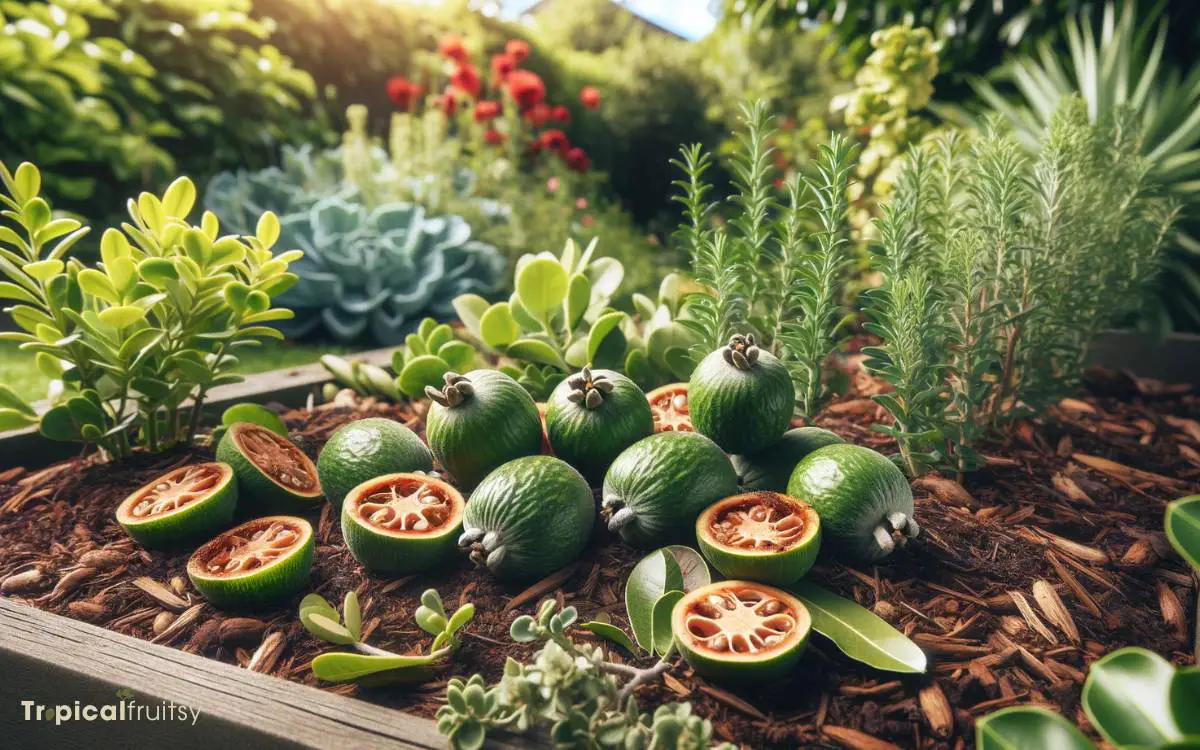
The aromatic properties of feijoa skins can also serve as a natural deterrent against common garden pests.
Gardeners seeking eco-friendly solutions will find that these fragrant skins repel unwanted insects without harming the environment.
Simply scatter the feijoa skins around the base of plants, especially those susceptible to pests. The scent is unappealing to many insects, effectively keeping them at bay.
Moreover, as the skins decompose, they enrich the soil with nutrients, providing a dual benefit for the garden. It’s a sustainable method that reduces waste and chemical use, aligning with environmentally conscious practices.
By opting for this natural repellent, gardeners can protect their plants and contribute to a healthier ecosystem simultaneously.
Can You Eat Feijoa Skin
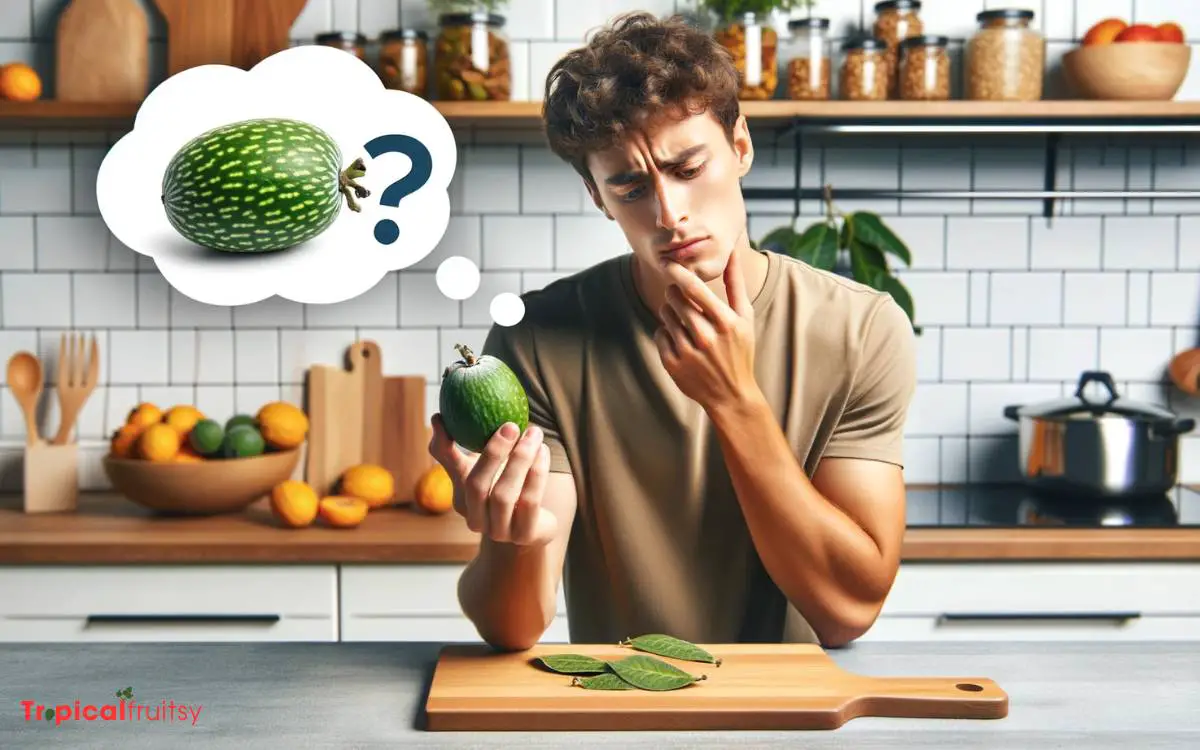
Yes, you can eat the skin of feijoa fruits. While the skin is edible, its taste and texture are not appealing to everyone. Some people find it a bit bitter or tough compared to the sweet, fragrant pulp inside.
However, the skin contains nutrients and fiber, making it a healthy addition to your diet if you choose to eat it. Whether to eat the skin is a matter of personal preference.
Many people prefer to scoop out the flesh and consume it directly, use it in recipes, or blend it into smoothies, leaving the skin aside. If you’re curious, you might want to try a small piece of the skin first to see if you like its flavor and texture.
Conclusion
In the garden of waste-not-wants, feijoa skins transform into treasures. They nourish soil as compost, whisper zest into teas, and polish our skin with sugar scrub grace.
They ripple through waters, casting hues into culinary art, and mingle in potpourri dances.
From their dried, powdered essence to their flavor extracts, they guard our green realms as pest sentinels. Embrace this cycle of rebirth, where every peel is a petal in sustainability’s ever-blooming flower.






